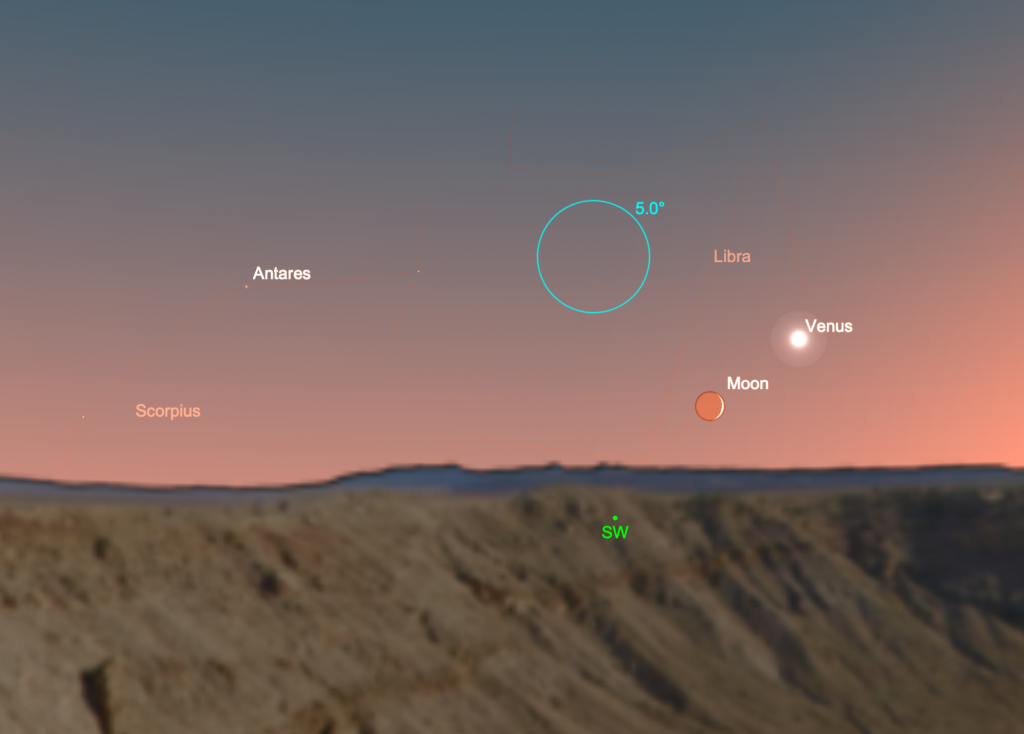
(Looking for last month’s ‘Night Sky’? Find it at this link…)
This time of year, you can also get in a good night of stargazing without staying up too late. The Milky Way and northern summer stars linger in the southwestern October sky. The autumn constellations such as Pegasus and Andromeda dominate overhead, and the northern winter stars are starting to poke above the eastern horizon in the late evening. Saturn remains prominent in the evening sky, while Jupiter and Mars rise high enough in the morning hours, both now big enough for promising telescopic observation. And a bright comet – possibly a very bright comet – arrives in the evening sky. Here’s what to see in the night sky this month…
1-15 October 2024. Over the next two weeks, northern-hemisphere observers with very dark sky can see the zodiacal light in the east about 90-120 minutes before sunrise. This whitish wedge of light appears to thrust upward from the horizon towards the constellations Gemini and Cancer. The zodiacal light is simply sunlight reflected off tiny dust particles in the inner solar system.
2 Oct. New Moon, 18:49 UT. An annular solar eclipse occurs over the south Pacific and extreme southern Chile and Argentina.
5 Oct. Look to the southwest to see a three-day-old Moon setting with Venus about 4o to the north. In the northern hemisphere, the pair lie low over the horizon after sunset; southern observers will see the pair at a higher elevation. Venus now shines at magnitude -4.0 and moves further south along the ecliptic during the month.
7 Oct. A fattening crescent Moon lies about 3o east of the bright red-orange star Antares in the southwestern sky after sunset.
9 Oct. Jupiter reaches its first stationary point as it appears between the horns of Taurus. It now begins moving westward in retrograde on its way to opposition in early December. The planet is nicely positioned for telescopic observation from now through February 2025. At mid October, the planet shines at an impressive magnitude -2.6, far brighter than any star, and spans about 44” in a telescope.
10 Oct. First Quarter Moon, 18:55 UT
11-31 Oct. Northern hemisphere observers can see – if all goes well – Comet C/2023 A3 (Tsuchinshan-ATLAS) in the evening sky after sunset starting around October 11 (or possibly even a few days before – if it’s long enough, you may see the tail setting a few days before you can spot the comet’s head). Comet watchers expect it to grow bright enough to see with the naked eye – and possibly bright enough to see in daylight! See an overview of the comet at this link.

12 Oct. Comet C/2023 A3 (Tsuchinshan-ATLAS) comes nearest to Earth at a distance of 0.47 AU or about 70 million kilometers.

14 Oct. A fat gibbous Moon lies 6o northeast of Saturn in the constellation Aquarius. (Observers in southern Africa, Madagascar, and India see the Moon occult Saturn. Details on timing for various locations are at this link). A month past opposition, Saturn shines at magnitude +0.7 and its disk appears nearly 19” across. The rings remain tilted only a few degrees from edge on. Also, about 7o west of the Moon tonight lies 8th magnitude Neptune just over the border in Pisces.
17 Oct. Full Moon, 11:26 UT (the Full Hunter Moon). The Moon also reaches perigee today, its closest approach to Earth, at a distance of 357,174 km. It therefore appears about 7% larger than average – what the ‘lay media’ calls a super moon.
19-20 Oct. The waning gibbous Moon passes through Taurus. On the 19th it lies 5o east of the Pleiades. On the 20th you see it 5o north of Jupiter.

20-21 Oct. The Orionids, one of the best meteor showers of the year, peak in the early morning hours today. They usually show as many as 20-40 fast-moving meteors per hour in dark sky. These meteors can appear anywhere in the sky and trace their paths back to the radiant near the top of the club of Orion. Maximum activity usually occurs between midnight and dawn. The waning gibbous Moon gets in the way of the faintest meteors this year, but the brightest meteors still shine through. Like the Eta Aquariids in May, the Orionids are tiny pieces of Comet 1/P Halley that strike the upper atmosphere as the Earth passes through the famous comet’s debris field.
23 Oct. In the morning sky, look for the (nearly) last-quarter Moon making a triangle with Castor and Pollux. Brightening Mars lies about 6o southeast of the Moon. The red-orange planet shines at magnitude +0.2 and spans about 8.7” in a telescope. Oct. 30 the planet moves eastward from Gemini in to Cancer. It continues to brighten quickly now on its way to opposition early next year.
24 Oct. Last Quarter Moon, 08:03 UT